Anchor Line Transatlantic Steamships - Tours - 1904
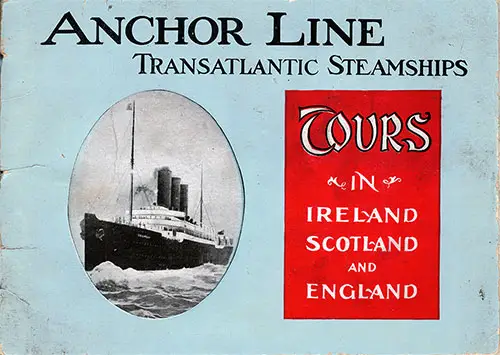
Front Cover, Anchor Line Transatlantic Steamships. Tours in Ireland, Scotland, and England. 1904 Brochure. GGA Image ID # 114ecb6abd
1904 brochure produced by the Anchor Line focuses on the most popular places of interest and principal cities of Scotland, Ireland, England, and Wales. The booklet features beautiful color images. Many are reproduced on this page.
ANCHOR LINE FLEET
Transatlantic, Peninsular, Mediterranean and Oriental Steamships
COMPRISING THE FOLLOWING:
- ALGERIA - 4,510 Tons
- ANCHORIA - 4,108
- ARABIA - 3.598
- ASIA - 3,011
- ASSYRIA - 6,354
- ASTORIA - 5,086
- AUSTRALIA - 3,595
- BAVARIA - 4,711
- BOHEMIA - 3,500
- BOLIVIA - 4,050
- BRITANNIA - 3,069 Tons
- CALABRIA - 4,376
- CALEDONIA - 10,000 (Building)
- CALIFORNIA - 8,410
- CIRCASSIA - 6,500
- COLUMBIA - 8,500 TONS REGISTERED
- DALMATIA - 3,318
- ETHIOPIA - 4,004
- FURNESSIA - 5,485
- HESPERIA - 3,037
- ITALIA - 4,000 Tons
- KARAMANIA - 8,150
- MASSILIA - 5,353
- NUBIA - 8,553
- OLYMPIA - 5,124
- PERSIA - 3,596
- PERUGIA - 3,654
- SCINDIA - 4,804
- VICTORIA - 3,558
EXCHANGE DEPARTMENT
Henderson Brothers sell Bills of Exchange and Drafts for one pound and upwards at lowest current rates, payable free of charge at banks in principal
cities and towns of Great Britain and Ireland.
FOR BOOK OF INFORMATION FOR PASSENGERS, RATES, ETC., APPLY TO
HENDERSON BROTHERS
GENERAL AGENTS
17 AND 19 BROADWAY, NEW YORK
176 JACKSON BOULEVARD, CHICAGO
THE outlines of different countries are frequently compared to the shape of different objects in nature. The British Isles may be compared in form to the three-leaved clover, Scotland representing the top leaf and England and Ireland corresponding to lower leaves on cither side.
Londonderry and Glasgow are situated, as it were, well up on the stem where the three leaves join. Londonderry occupies the same relative position of importance in the north of Ireland as Queenstown does in the south.
All arteries of travel throughout Ireland have convenient connections with this upland city. Glasgow is situated at what may be called the '‘threshold of Scotland.”
As the commercial metropolis of Scotland, the transportation facilities possessed by Glasgow are such as to bring it into close contact not only with all parts of Great Britain, but with all parts of Europe and, indeed, of the world. Londonderry and Glasgow are the transatlantic terminals of the Anchor Line.
In taking a vessel of this Company for a voyage to the scenes set forth in succeeding pages, the tourist is assured that by so doing he can make such tours with the utmost convenience and economy. For Schedule of Tours see pages 38 and 39.
Moville, at the entrance of Lough Foyle, is the Irish terminal of the Anchor Line. The first land sighted is Tory Island, next Instrahull Island, and finally Lough Foyle and Moville are reached, where passengers are transferred by the Company’s steam tenders up the Lough and River Foyle to Londonderry.
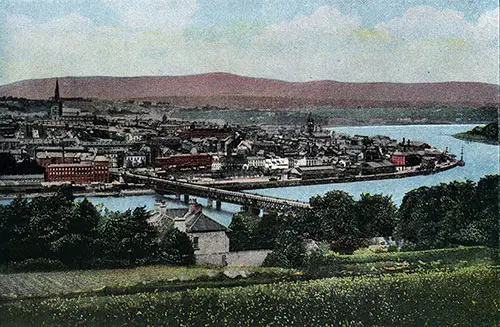
View of Londonderry, Ireland circa 1900. GGA Image ID # 114c8f85f6
Londonderry forms a convenient starting point for all the interesting places to be visited in Ireland. It is situated on an elevation lit) feet above the river level. The former name of the city was Derry, the prefix London being added in 1613.
The ancient portion is surrounded by walls pierced by seven gates, known as Bishop's Gate, Butchers Gate, Ferry Gate, Skipquay Gate, Castle Gate, New Gate and Magazine Gate. Hie Siege of Londonderry in 1689 rendered the city memorable in history.
At Bishop’s Gate was constructed the Triumphal Arch in honor of William III. Here also may be seen the handsome column erected to the memory of Rev. George Walker, the hero of the siege.
The Cathedral, the Government House and the Presbyterian College are among the points of interest. The chief industry is shirt manufacturing, which affords employment to upwards of 20,000 persons.
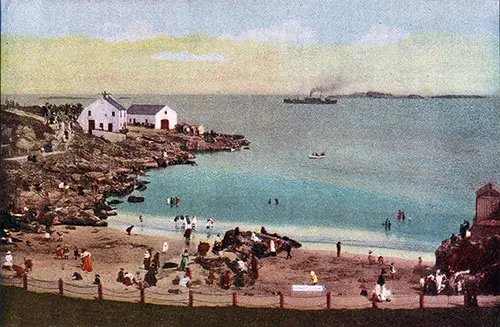
View of the Harbor at Portrush, Ireland circa 1900. GGA Image ID # 114c914220
Portrush, the most northerly town in Ireland, is a picturesque watering place with wild and rocky coast .lines and commanding an attractive view of the Donegal Mountains.
It forms a convenient center for trips to the various places of interest in the northeast. Port Stewart, another interesting northern point, is within easy driving distance from Portrush.
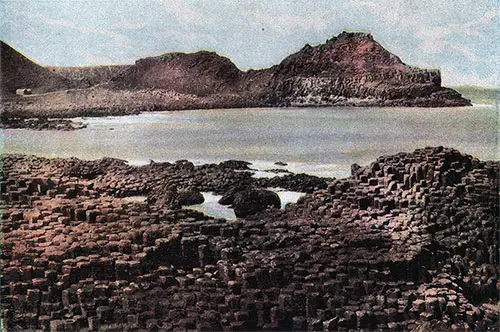
View of Giant's Causeway circa 1900. GGA Image ID # 114d05fa3a
Giant’s Causeway is a very wonderful formation of columnar basalt about 1,000 feet in area. It received its name from a tradition that it formed a causeway for giants to cross the North Channel to Scotland.
The columns are upright and chiefly hexagonal in shape. The diameter varies from fifteen to twenty inches. The columns are so closely set together in some places as to render it impossible to insert the blade of a knife.
The different heights of the columns are formed by three strata of rock, which give rise to what are known as the Little, Middle and Large Causeways.
Different portions are given special names, such as Giant’s Head, Nurse and Child, and Giant’s Organ. While in this neighborhood one should visit the ruins of Dunluce Castle, Dunseverick Castle, and the Carrick-a-Rede Rope Bridge.
Innishowen Peninsula contains many points of interest. A convenient center from which to visit these places is Buncrana, an attractive watering place on Loch Swilly. One should go to the Gap of Mamore, the Minliagh Lakes and Mountains, Dunrce Head with its fort and lighthouse, Binion Bay, Lcnan Head and Pollen Strand.
Lough Erne Region. The region embracing Bundoran, Ballyshannon, Beeleek, Castlecaldwell, Sligo and Lough Erne abounds in beautiful scenery. At Bundoran the views are superb. The town itself is a fashionable watering place, and is the best starting place for a tour of the Donegal Highlands.
There are Upper and Lower Lough Erne, the latter being navigated by steamer and abounding in points of interest and features of scenic beauty.
The Capital of Ireland, Dublin, is attractive both in itself and in its environments. It possesses beautiful squares, terraces and streets, the most noted thoroughfare being Sackville Street. There are many fine statues of Nelson, Wellington, Goldsmith, Burke and others.
Points of interest are Trinity College, Bank of Ireland, St. Patrick’s Cathedral, and Phoenix Park. An attractive drive may be taken by the road which skirts the city for nine miles. The Hill of ITouth, eight miles from Dublin, commands a magnificent prospect.
The Irish Switzerland comprises the charming section known as The Dargles, through which the tourist may pass by means of a jaunting car, or may even walk. The Glen of the Downs, the Vale of Avoca, and other points in the picturesque County of Wicklow, are easily accessible by a short rail journey from Dublin.
Blarney Castle with the famous Blarney Stone and the lake are favorite resorts for tourists, and are but five miles distant from Cork. The Castle is a fine ruin, and the Blarney Stone on the southern wall is said to give the gift of cajolery to all who kiss it.
The Bells of Shandon, immortalized in Mahoney's famous poem, are a feature of interest in Cork, being in the Church of St. Anne Shandon. Cork is a parliamentary borough, has a notable harbor as w^ell as interesting public institutions, and forms a convenient center for towns in the South of Ireland.
Eighteen miles south of Cork is Queenstown, which was named in honor of Queen Victoria on the occasion of her visit in 1849. The most imposing building is the Homan Catholic Cathedral.
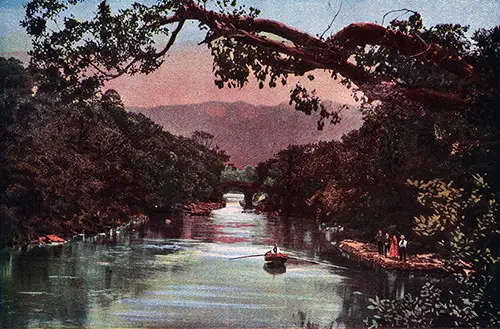
Meeting of the Waters in Killarney circa 1900. GGA Image ID # 114d20ffaa
Lakes of Killarney are remarkable for their varied scenery and rich blendings of lake and mountain. On the west are Macgillicudy’s Reeks and Purple Mountains, while Tore, Mangerton and the Punch Bowl lie to the south and east.
The varieties of color from light green to deep brown, and the contrasts of rock and verdure, valley and mountain, with peaceful winding waters between, are unsurpassed. The drives about this region are delightful. The Gap of Dunloe, Glengarifï, and other points in the neighborhood will interert the tourist.
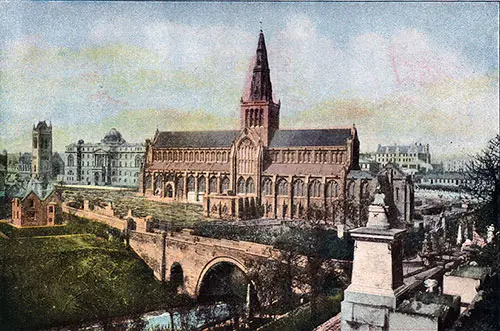
View of the Glasgow Cathedral circa 1900. GGA Image ID # 114dabd9c4
GLASGOW is noted as the commercial metropolis of Scotland and second city of Great Britain. Though thoroughly modern in its general aspects, the older portions of the city retain many features of historic interest.
The venerable Cathedral is the most notable specimen of old ecclesiastical architecture in Scotland. The nucleus for the newer portion of the city is the stately University.
George Square contains, among other public edifices, the handsome Municipal Buildings with their notable interior effects. The city contains many fine monuments, parks, institutions of science and art, and places of amusement.
The water supply, from Loch Katrine, is unexcelled. The city is a convenient center for tours throughout Great Britain, and particularly for all points in Scotland.
The Land of Burns. A short journey of two hours by rail from Glasgow brings the tourist to the picturesque coast town of Ayr, where may be seen the Burns Cottage containing many relics of the poet.
Here also is the Burns Monument, and beyond the Monument Grounds may be seen the road of Tam o’ Shan tor’s famous ride, Alloway’s Haunted Kirk, and the “Banks and Braes o’ Bonnie Boon.” The notable Wallace Monument is situated on the opposite side of the river.
The Royal Route. Of the various routes to the Highlands, the most enjoyable is by steamer “ Columbia” or steamer “Iona” from Glasgow to Rothesay, the Scottish Newport, and thence through the charming Kyles of Bute to Ardrishaig, at which point passengers land, continuing the trip to Oban and the North via the Crinan Canal and Loch Awe.
On this loch may be seen the noted Kilchurn Castle. From Glasgow to Ardrishaig and return the distance covered is 180 miles, and the trip can be made in one day.
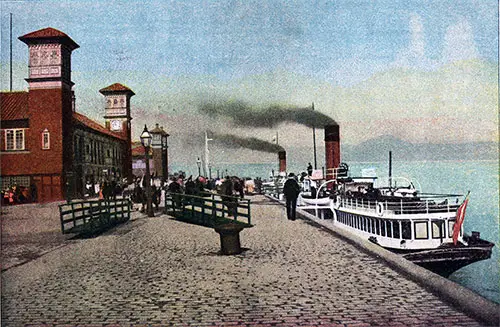
Princes Pier in Greenock circa 1900. GGA Image ID # 114dbce261
Tourists can take the steamer at Glasgow and so obtain a near view of the great shipbuilding yards and docks, Dunglass Castle and Dumbarton Castle, or take train to Greenock an hour later, connecting with steamer at Princes Pier, and proceed via the popular resorts of Kilercggan, Dunoon and Innellan, and many other points of interest to Ardrishaig.
The Lake District. Starting from Glasgow one can make the round of the Scotch Lakes in a single day. Many prefer, however, to spend a longer time amid such inviting scenes.
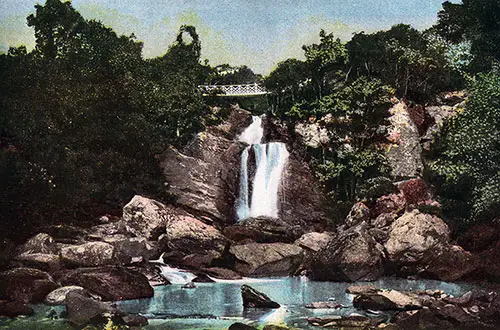
View of Inversnaid Falls in Loch Katrine circa 1900. GGA Image ID # 114dedd92d
The route is by rail to Balloch, thence across Loch Lomond—a typical Scotch lake—to Inversnaid, whose Falls are made famous by Wordsworth. Here Ben Lomond towers to a height of 3,192 feet.
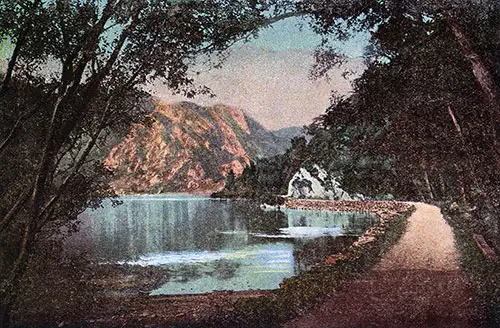
Path By Loch Katrine circa 1900. GGA Image ID # 114dfbb9f1
A drive of five miles brings the tourist to Loch Katrine, immortalized in Scott’s “ Lady of the Lake.” Proceeding to Callander, the road winds through the famed Trossachs, noted for the variety and beauty of the scenery.
This region is identified with the exploits of Rob Roy, so famous in Scottish song and story.
Two Famous Castles. The journal of the late Queen Victoria describes Oban as “one of the finest spots we have ever seen.” The ruins of Dunollie Castle, mantled in green, overlook the bay, while Dunstaffnage Castle surmounts a peninsula jutting into Loch Etive.
The latter was formerly a seat of the Scottish monarchy, and from this castle was taken the Stone of Destiny now supporting the Coronation Chair in Westminster Abby. Beyond Loch Etive lies Glencoe (Glen of Weeping), memorable for the fearful massacre on the thirteenth of February, 1692.
Fingal’s Cave. Staffa, a small island off the west coast of Mull, is remarkable for its curious basaltic formations, and particularly for its numerous caves, of which the most noted is Fingal's.
The sea forming the floor of the chamber throws up weird phosphorescent lights. At mean tide the top of the arch is sixty-six feet high, while the length of the cave is 227 feet, and the breadth fifty-four feet.
The ranges of columnar basalt supporting the arch are similar to those of the Giant's Causeway, with which they are supposed to be connected.
Seat of the Druids. Iona, the most famous island of the Hebrides, in ancient times witnessed the rites of the Druids. St. Columba visited the island in A.D. 563, and prophesied that it should be “honored not only by Kings of the Scots and their people, but by the rulers of strange nations and those subject to them.”
Many Scotch, Irish, Norwegian, and even French Kings have been buried there, thus fulfilling the prophesy. Some ruins of old monasteries still remain, the oldest ruins being those of St. Oran’s Chapel. Maclean’s Cross, the oldest in Scotland, is one of 860 that once marked the island. Bede set down the area of Iona as “five families or five hides of land." It comprises about 2,000 acres.
Caledonian Canal. The route to Inverness is by this great waterway, partly natural and partly artificial, which takes a northeasterly course entirely across Scotland, cutting the country in two.
The canal proper extends twenty-four miles and utilizes thirty-eight miles of natural lakes. It will accommodate vessels of 1,000 tons burden. Banavie at the entrance is overshadowed by gigantic Ben Nevis, the monarch of British mountains, towering to a height of 4,406 feet.
While traversing the Canal and lakes there are many interesting places to claim attention, such as Fort William, Inverlochy Castle, Tor Castle, Achnacarry Castle, and the Falls of Foyers.
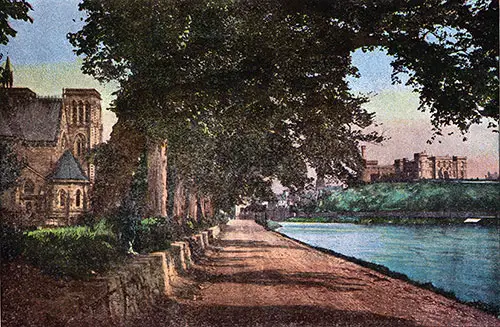
Iverness Cathedral and Castle from the Ness circa 1900. GGA Image ID # 114e18f386
Capital of the Highlands. This application has been given to Inverness. This ancient and picturesque town dates back to the twelfth century, when it received its charter from William the Lion.
The business portion occupies a flat region on either side of the river, while new streets and villas ascend the slopes. The finest view is obtained from Castle Hill.
Four miles distant is the battlefield of Culloden. The town is remarkably clean and well built. Interesting excursions can be made in the neighborhood, the principal one being to Culloden Moor, the site of the last battle fought in Great Britain.
Stirling and Stirling Castle are a short journey by rail from Glasgow. The town is ancient and picturesque. The Castle, said to be 900 years old, is built on an abrupt craig overlooking the city.
The views from the Castle are probably the finest in Scotland, including the battlefields of Stirling and Bannockburn, the old Bridge of Stirling, the Wallace Monument of Abbey Craig and Cambus Kenneth Abbey, the Western Grampians, the windings of the Forth, the vales of Teith and Allan, and other notable scenes. The Smith Institute with valuable collections, and the Guild Hall are among the sights of the town.
The Land of Scott. A trip of about 30 miles southeast from Edinburgh brings the tourist among scenes made famous by the writings of Sir Walter Scott. The author’s remains repose in Dry burgh Abbey. In "The Lay of the Last Minstrel” the more ornate Abbey of Melrose is depicted.
Abbotsford, the home erected by Scott, the grounds of which contain many trees planted by him, is interesting not only in itself, but also for the many curios and relics contained.
Edinburgh, ‘‘Scotia’s darling seat,” according to the bard, the romantic capital of the ancient Kingdom of Scotland, ranks as one of the most beautiful cities in the world.
The Old Town stretching from Castle Rock to Holyrood possesses much of picturesque and historic interest, while the New Town, as represented by Princes Street, forms a striking contrast.
The best view is obtained from the Castle. The tourist will find many places of special interest in and about the city, such as John Knox’s House ; St. Giles’ Cathedral, where John Knox ministered ; Moray House, where Oliver Cromwell lived, and Scott’s Monument.
Edinburgh Castle has many points of interest, among which may be mentioned the Crown Room, containing the Scottish regalia; St. Margaret’s Chapel, the oldest building in Edinburgh; the Citadel, Queen Mary’s Room, and the Banquet Hall. The Castle is most intimately associated with the life and vicissitudes of Scottish royalty.
Holyrood Palace and Chapel. The stately ruins of Holyrood lie eastward of Edinburgh. The associations of the Palace with Mary, Queen of Scots, have enveloped it with romantic associations. The Abbey was erected by David I in 1128.
The visitor should inspect the Abbey Sanctuary, Guard House, Fountain, Picture Gallery, Lord Darnley’s Room, Chapel Royal, Queen Mary’s Dial and her Bath, and Queen Mary’s Apartments.
ENGLAND possesses so many features of picturesque and historic interest that it will not be feasible to do more in these pages than to indicate in a general way some of the leading centers, each of which contains a group of important points. All such places in England are easily accessible from Glasgow and London.
London. It is an old saying that “all roads lead to London,” and there is some truth in the expression ; for the great metropolis is, indeed, a world center. No adequate description of it could be condensed into a small compass.
Such important features as the Houses of Parliament, Westminster Abbey, St. Paul’s Cathedral, the Tower of London, Bank of England, Royal Exchange, Mansion House, British Museum and others, are too well known to need recapitulation.
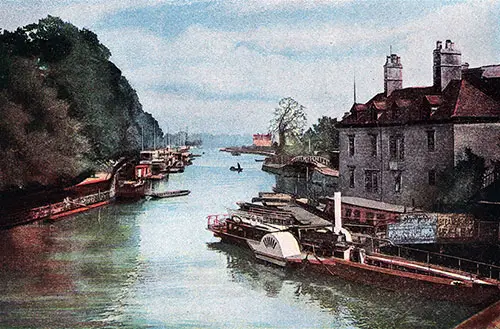
View of the Thames circa 1900. GGA Image ID # 114e4113f4
Suburban London is no less interesting. Greenwich with its Hospitals and Observatory, Woolwich Arsenal, the Dulwich Gallery of Paintings, Hampton Court, Kew Gardens, and Richmond on the Thames, with its Boating and Park, should all be seen.
One should also visit Windsor Castle, founded by William the Conqueror, and the home of so many English Kings and Queens. Windsor is about one hour’s ride by rail from London.
The Lake District. The English Lakes in Cumberland, which were immortalized by Wordsworth, are famed for their beauty. The lakes are Windermere, Derwentwater, Bassenthwaite, Thirlmere, Grassmere and Rydalmere. Windermere is the largest of the English Lakes, being ten and a half miles long and one mile broad at its widest part. Furness Abbey, in the Lake District, is the finest ruin in the North of England.
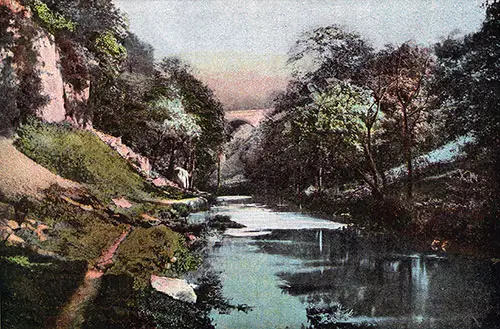
View of Cheedale - Derbyshire circa 1900. GGA Image ID # 114e240b02
The Midlands, comprising Derbyshire and vicinity, with its world-famed scenery and fashionable watering places, should always be included in the tourist's itinerary.
Shakespeare’s Country is a veritable Mecca for English-speaking tourists. The house in which the poet was born is still in a good state of preservation, as is the home of Anne Hathaway.
The Memorial Theatre and the American Fountain will also repay a visit. Warwick Castle, a feudal fortress ; Kenilworth, immortalized by Scott, and Leamington, the fashionable resort, should not be passed by.
North Wales District. The wild and rugged scenery of Wales renders it comparable with Switzerland. The stupendous ruins of ancient might to be seen in Conway, Carnarocn and Harlech Castles, recall the conflict of centuries.
The ancient English town of Chester with its Roman walls is a convenient center for tours in this region. A short drive brings the tourist to Hawarden, famous as Gladstone’s home.
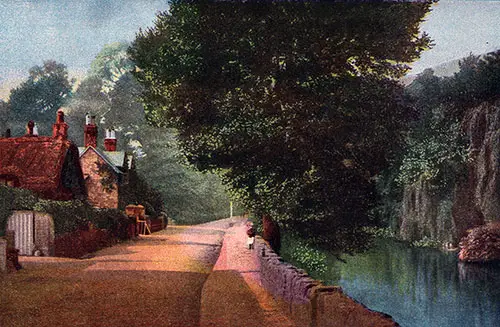
View of Bonchurch Pond on the Isle of Wight circa 1900. GGA Image ID # 114ebdc077
Isle of Wight, off the south coast of England, reached by rail and steamer in about three hours from London, is one of the most beautiful parts of the kingdom, presenting almost every variety of landscape in miniature.
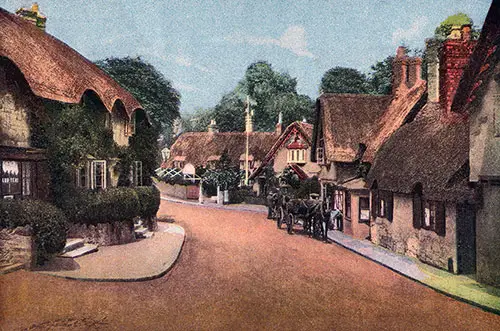
Town of Shanklin on the Isle of Wight circa 1900. GGA Image ID # 114e662a48
The principal towns, Newport, Yarmouth, Cowes, Hyde, Ventnor, Shanklin and Sandown, are greatly frequented in summer as popular bathing places and yachting stations.
The island will ever be sacred to Englishmen owing to its being the site of the stately palace known as Osborne House, the favorite residence of the late and beloved Queen Victoria.
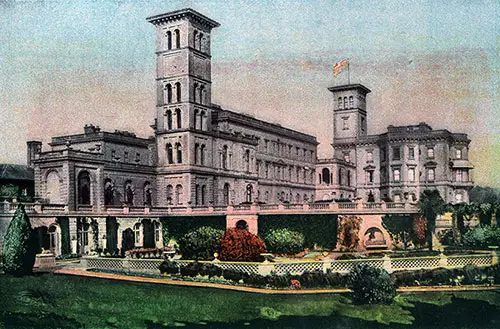
Osborne House on the Isle of Wight circa 1900. GGA Image ID # 114e78023b
The drives by four-in-hand coaches, which start daily from all the important towns, make tours around and through the island which are greatly enjoyed by all who indulge in such.
Trains leave Waterloo and Victoria Stations, London, for the Isle of Wight, via Portsmouth or Southampton, several times daily. It is a delightful trip of about three hours, through some of the prettiest scenery in England.
Should the tourist desire to extend his travels to the Continent, he can, of course, do so very readily from London, Glasgow or any other important part of Great Britain.
Anchor Line
IN boarding one of the fine vessels of the Anchor Line, with the preceding tours in view, the American traveler will find that the construction and equipment, of his temporary home on the deep are according to the best standards of modem travel.
The S. S. “Columbia,” shown in the above illustration, is the latest addition to the Anchor Line fleet of Atlantic steamers. She is a magnificent vessel of 8,500 tons register, and makes the trip from Pier 54, North River, New’ York, to Glasgow in eight days.
With numerous water-tight compartments, commodious and well-appointed saloons, ample and homelike staterooms, superior light and ventilation, and spacious decks, everything is provided to minister to the safety and comfort of passengers.
This ship, with other favorite vessels of the Anchor Line (the “Furnessia,” “Astoria,” “Anchoria” and “Ethiopia”), will maintain the regular weekly service to the North of Ireland and Scotland during the season.
Nothing remains but to wish the prospective tourist bon voyage, assured that while on ship-board, as well as while viewing the beauties and wonders that are before him, he will pass his anticipated holidays with pleasure, inspiration and profit.
Convenient Hotels to the Anchor Line Piers in Glasgow are the St. Enoch and Caledonian Railway Hotels, and in New York, The Chelsea, on Twenty-third street between Seventh and Eighth avenues, where satisfactory accommodations can be obtained at reasonable rates.
Hints for Travelers
Do not take more baggage than is absolutely necessary ; it will only cost you extra if your travels take you to the Continent.
Have your name plainly marked on every piece of baggage, also the number of your stateroom.
For spending-money, carry a supply of Anchor Line Drafts, which can be obtained of all Agents.
Steamer chairs can be hired for the ocean trip on payment of $1.00 when taking your ticket, or at the Company's Pier before sailing.
Anchor Line Services
NEW YORK and GLASGOW Via Moville (Londonderry)
Steamers of this service are intended to sail Every Saturday from New York
Thursday or Saturday of each week from Glasgow and the following day from Londonderry.
CABIN PASSAGE RATES
According to steamer and accommodations, $50 to $125.
For particulars consult "Rate Sheet,” showing plans of each steamer’s cabins, and giving prices for each berth.
All Saloon Passengers have equal privileges, the difference in fare being due solely to the location of or number of persons berthed in the rooms.
EXCURSION TICKETS are issued on most favorable terms.
Anchor Line Wharf, Pier No. 54, North River, foot of West 24th St. Adjoining the Ferry Slips of the Pennsylvania and Erie Railroads.
Passenger Accommodations
First Cabin passengers are furnished with a liberal table, including all the delicacies of the season, and everything necessary on the voyage. Wines and liquors of finest quality can be had on board at moderate prices.
The Dining Saloons, Music Hall, Ladies’ Boudoir and Gents’ Smoking-rooms are all located on the Main and Spar Decks, and, by means of electric bells, are in communication with the Steward’s department. All are fitted up in the most elegant and luxurious style, and with every regard for the comfort and convenience of passengers.
Every steamer carries a duly qualified Surgeon and an experienced Stewardess, and is provided with a Piano, Organ and select Library, including all the latest Guide Books of European travel.
State Rooms are located on the Main or Spar Decks, are large, well
lighted, perfectly ventilated and elegantly furnished, accommodating two, three and four passengers each. All State Rooms are provided with electric bells connected with Steward's department.
Berths can be secured in advance by payment of a deposit of $25 each (balance of passage money payable one week previous to sailing day of steamer).
For Plans of Cabins, Passage Tickets, or Further Information, Apply to any of the Agencies of the Line.
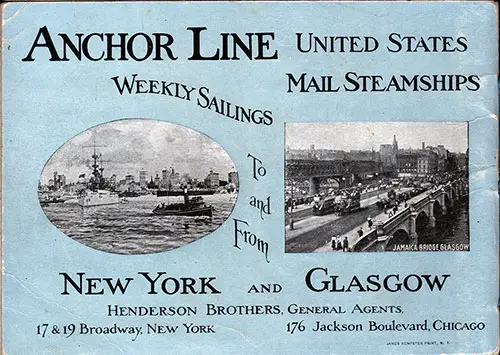
Back Cover, Anchor Line Transatlantic Steamships. Tours in Ireland, Scotland, and England. 1904 Brochure. GGA Image ID # 114ed01e21
